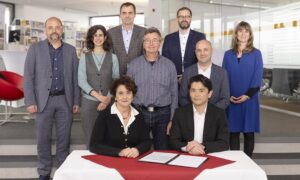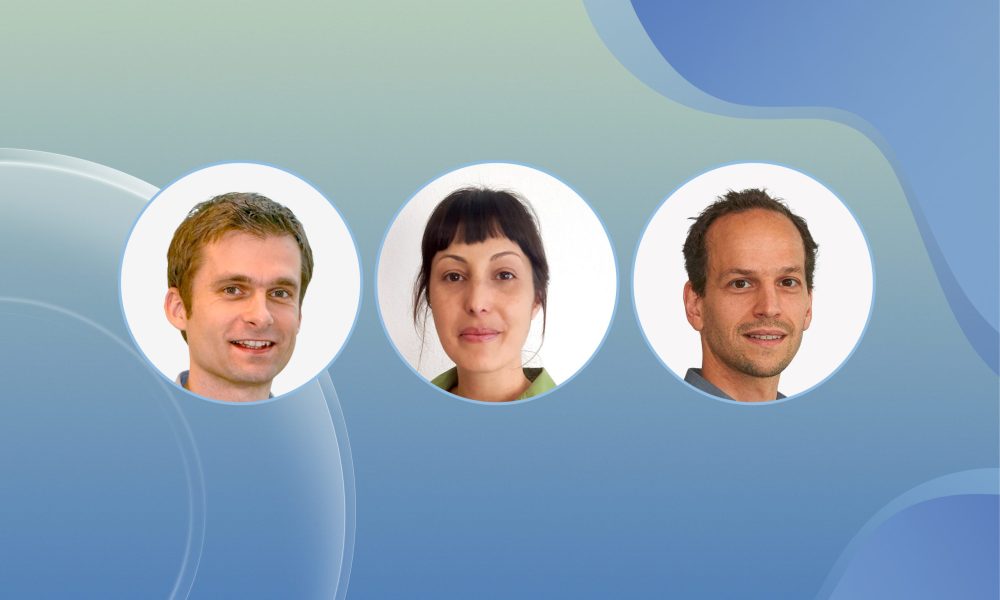
Read the latest Issue
Jan Kosinski, Julia Mahamid, and Georg Zeller have received grants to enable ambitious projects aimed at mapping the cellular protein synthesis machinery in context and understanding complex host-microbiome interactions, respectively

Three EMBL researchers have been awarded prestigious ERC Synergy Grants for their collaborative projects. Jan Kosinski from EMBL Hamburg and Julia Mahamid from EMBL Heidelberg received the award for their project ‘TransFORM’, for which they will receive funding of 2.5 million and 4.6 million EUR respectively, to be used over a period of six years. Georg Zeller from EMBL Heidelberg was recognised for his project ‘CartoHostBug’, for which he will also receive 2.5 million EUR over the next six years.
The ERC Synergy grants are awarded to groups of two to four group leaders working together and bringing different skills and resources to tackle ambitious research problems.
Proteins are the workhorses of our cells, and their synthesis is a precisely regulated process (also called ‘translation’) carried out by sophisticated molecular machinery. Such machinery, mainly consisting of structures called ribosomes and regulatory proteins, interact in complex ways with each other and the cellular microenvironment. However, the molecular complexes that make up the protein synthesis machinery have mainly been studied in isolation and outside the context of the cell.
The TransFORM project aims to address fundamental questions related to the specific composition of these diverse molecular complexes, their significance, and their functions inside human cells. The synergy team consists of EMBL group leaders Julia Mahamid and Jan Kosinski, Rachel Green from Johns Hopkins University, and Juri Rappsilber from Technische Universität Berlin. It thus brings together experts in in-cell structural biology method development and in the biology of translation regulation. The researchers will use a variety of model systems, ranging from single cells to 3D organoids, to study how the translation machinery responds to various cellular states and stressors such as viral infections.
“The ERC synergy grant we’ve received will pave the way for the development of innovative computational methods for structural modelling based on in-cell crosslinking mass spectrometry and cryo-electron tomography data,” said Kosinski. “Working in close collaboration with experts in these techniques ensures that our methods will tackle the most pressing challenges effectively. While our initial focus within the ERC project will be on translation complexes, our methods will be applicable to other biological systems, thus ensuring a broader impact on in-cell structural biology.”
“Our team aims to synergistically develop a transformative combination of in-cell methods of cryo-electron tomography, with imaging across scales, in conjunction with crosslinking mass spectrometry, and integrative structural modelling to resolve the diversity of translation complexes at atomic detail across subcellular space,” said Mahamid. “Only such next-generation structural biology approaches, combined with high-resolution biochemistry and functional assays, can provide a detailed and holistic understanding of the complex regulation of this fundamental gene expression process.”
The human microbiome, comprising the many billions of microorganisms that inhabit our bodies, contributes to our health and disease in myriad ways. Georg Zeller’s team at EMBL Heidelberg develops cutting-edge computational and imaging tools to study the microbiome and how it is shaped by interactions with the host.
The gut microbiome is usually studied by metagenomic sequencing of microbial communities in bulk, a process in which all spatial information – where in the body specific microbes are located and which human cells they interact with – is lost. The CartoHostBug project, a collaboration between the Zeller Group and teams led by Eduardo Villablanca from the Karolinska Institute, Stefania Giacomello from the KTH Royal Institute of Technology and Julio Saez-Rodriguez from the University Hospital Heidelberg, aims to change this. It will help scientists study the spatial architecture of microbiome-host crosstalk in the human gut, using a combination of novel imaging approaches, spatial transcriptomics technologies and computational modelling techniques.
The researchers aim to reconstruct how microbial composition as well as host gene expression varies across the gut in healthy individuals as well as in patients with inflammatory bowel disease or colon cancer. Using this information, they will characterise local communication networks and niches occupied by specific microbial species and host cells. By combining this data with the results of experiments where this system is artificially perturbed, the researchers aim to develop computational models of gut ecosystem niches to gain new insights into the biological processes underlying host-microbiome interactions in health and disease.
“I’m extremely happy that we got funded to implement this exciting project and work with such an amazing team!” said Zeller. “This really puts us in a position to get unprecedented high-resolution views on the human gut microbiome in its native spatial context. I’m sure that the spatial data will revolutionise our current understanding of microbe-host interactions, which is largely based on bulk sequencing data.”
Read the full announcement by ERC about this year’s Synergy Grants on their website.
Looking for past print editions of EMBLetc.? Browse our archive, going back 20 years.
EMBLetc. archive